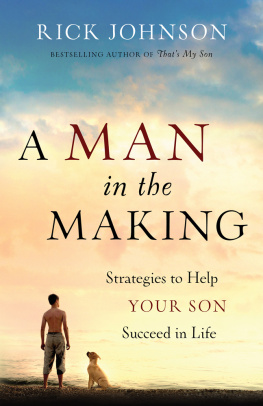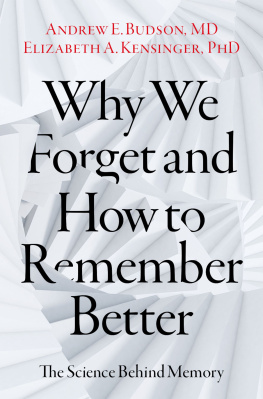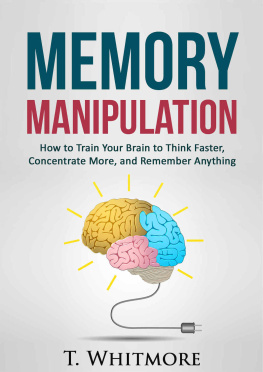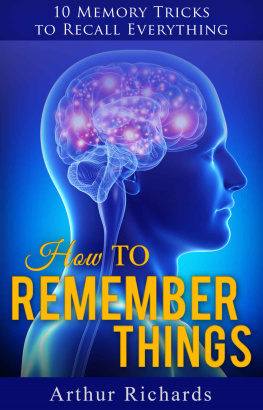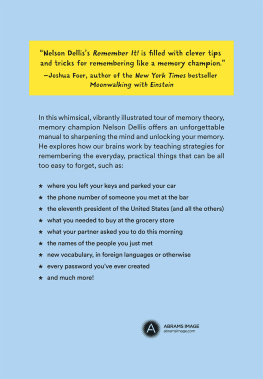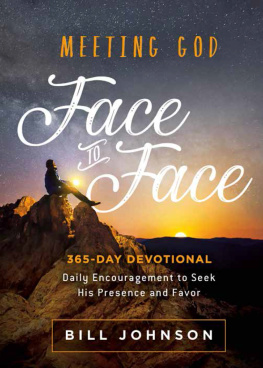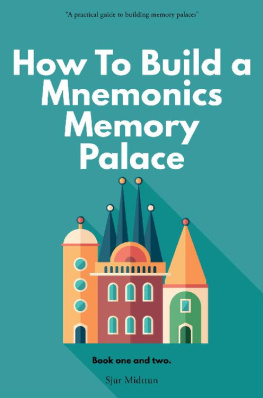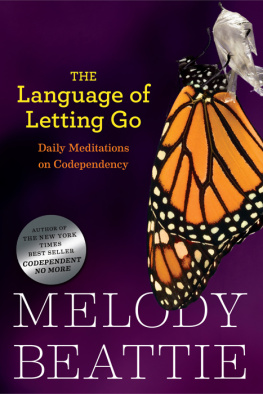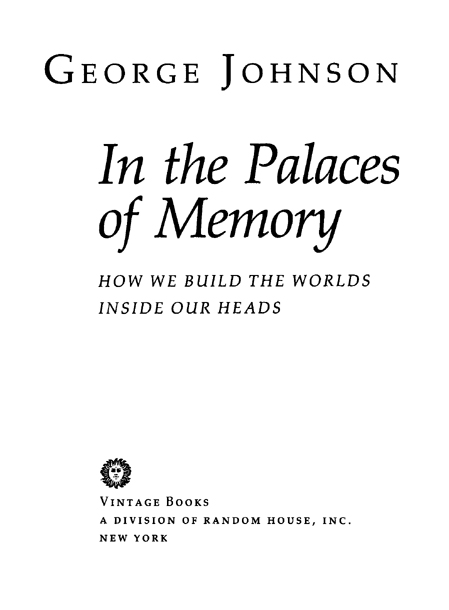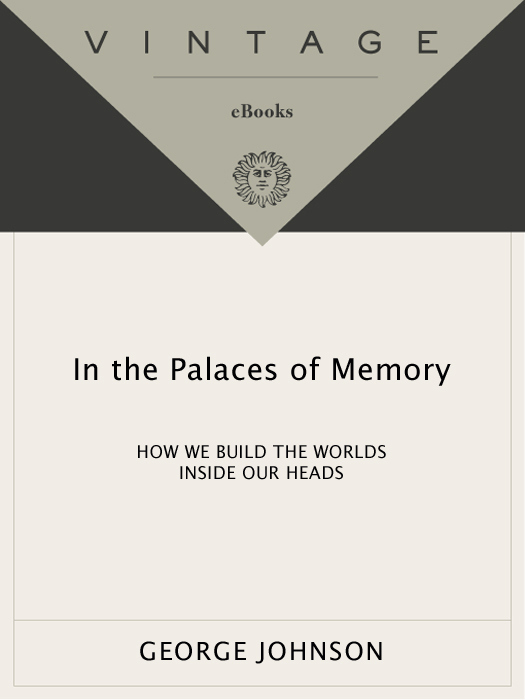
G EORGE J OHNSONS
In the Palaces of Memory
In the Palaces of Memory is a sophisticated, comprehensive and fascinating analysis of the science of memory. Johnson has achieved a rare blend of scientific and literary sophistication. Faithful to its complexities and controversies, the book is a fully dimensional portrait, a hologram, of the field.
Richard Mark Friedhoff, USA Today
As a writer about the biological and human sciences, Mr. Johnson has few peers. If I wanted to give readers a feeling for the frontiers of cognitive neuroscience, I would send them directly to this book.
Howard Gardner, The New York Times
Among the liveliest and most readable accounts of neuroscience to have appeared in recent years In the Palaces of Memory belongs in the library of everyone interested in the study of the brain.
Timothy Ferris,
author of Coming of the Age in the Milky Way
Lucid, insightful Mr. Johnson imparts a huge amount of information in his clear descriptions of how the relevant experiments were conducted and interpreted. And he makes the reader feel the excitement that drives these people to devote most of their waking hours over a number of decades to the puzzle.
John C. Marshall,
The New York Times Book Review
An eloquent foray into how our brains convert experience into knowledge. [Written] with all the alacrity of a detective gathering clues with a lucidity that at times approaches artistry.
Thea Singer, Boston Phoenix
George Johnson is an extremely gifted member of a small group of writers who popularize science. Science writers of genius, like George Johnson, should be put on the public payroll.
Clarence Brown, Trenton Times
How does the brain create memories? This elegantly written report is science on the cutting edgemessy, intuitive, exciting.
Publishers Weekly
Interspersing personal interviews with a mastery of recent advances in artificial intelligence, neurobiology, and philosophy of mind, George Johnson is a Rolls Royce of a science writer.
John Allen Paulos, author of Innumeracy
George Johnson masterly brings these brilliant, sometimes quirky people to life. With the kind of curiosity that has driven John McPhee into greenmarkets and orange groves he moves gracefully from wetware to hardware to software, keeping the reader with him all the way.
Kathy Traxler, San Diego Tribune
ALSO BY GEORGE JOHNSON
ARCHITECTS OF FEAR:
Conspiracy Theories and Paranoia in American Politics
MACHINERY OF THE MIND:
Inside the New Science of Artificial Intelligence
Copyright1991 by George Johnson
All rights reserved under International and Pan-American Copyright Conventions. Published in the United States by Vintage Books, a division of Random House, Inc., New York, and simultaneously in Canada by Random House of Canada Limited, Toronto. Originally published in hardcover by Alfred A. Knopf, Inc., New York, in 1991.
Library of Congress Cataloging-in-Publication Data
Johnson, George, 1952 Jan. 20
In the palaces of memory : how we build the worlds inside our
heads / George Johnson.
p. cm.
eISBN: 978-0-307-76546-8
1. Memory. 2. Neuropsychology. 3. Neurology. I. Title.
[QP406.J64 1992]
153.12dc20 91-50556
v3.1
For Ron Light
CONTENTS
PREFACE
Invisible Palaces
PRELUDE
The Tower in the Jungle
PART ONE
Mucking Around in the Wetware
FIRST INTERLUDE
A Brain in a Box
PART TWO
The Memory Machine
SECOND INTERLUDE
God Is a Tinkerer
PART THREE
The End of Philosophy
PREFACE
Invisible Palaces
You can never dismantle all these modem mental structures. There are so many of them that they face you like an interminable vast city.
S AUL B ELLOW , The Bellarosa Connection
W HENEVER YOU READ A BOOK or have a conversation, the experience causes physical changes in your brain. In a matter of seconds, new circuits are formed, memories that can change forever the way you think about the world. I find that idea so remarkable that for the last three years it has been difficult for me to maintain much of an interest in anything else. How is it that memory leaves its mark so that we are able to carry around the past inside our heads?
It has only been in the last few years that scientists have begun to come up with good theories of how this might happen. By breaking down some of the walls that have traditionally divided their fields, psychologists, biologists, physicists, and philosophers are joining in an attempt to answer some of the great questions of human existence: How do we know what we know? How do we make the mental mapsthe structures of memoriesthat serve as our guides to the world?
Its a little frightening to think that every time you walk away from an encounter, your brain has been altered, sometimes permanently. The obvious but disturbing truth is that people can impose these changes against your will. Someone can say somethingan insult, a humiliationand you carry it with you as long as you live. The memory is physically lodged inside you like a shard of glass healed inside a wound.
For someone like me who has always taken an absolutist view of the First Amendment, this idea raises problems that are difficult to resolve. Freedom of speech is based on the old dualist notion that mind and body are separate things. Hurting someone with a rock is different from hurting someone with an idea. But is it really? As science continues to make the case that memories cause physical changes, the distinction between mental violence, which is protected by law, and physical violence, which is illegal, is harder to understand. Who hasnt had the experience of seeing something so horrible and ugly that it was burned in the brain forever? Ill never forgive David Lynch for his movie Eraserhead.

Memory is clearly one of those subjects that can expand to engulf volumes. In an attempt to hold it at bay, I have written this book in three sections. Each is a story of someonea biologist, a physicist, and a philosopherwho is trying to learn how memory works.
As in my last book, Machinery of the Mind, Im writing about science in the making, not science already done. By working so close to the cutting edge, Ive been able to watch the contest before the final results are in. Science is too often prettied up in retrospect. Once a theory becomes enshrined as the winner, the competition is quickly forgotten. But its in the messy, sometimes irrational part of the scientific horse race that one can see a mind at work, confronting the unknown.
In most newspaper accounts, science comes off looking like butterfly-collecting. Facts are captured in a net, chloroformed, and pinned with labels on a Styrofoam board. The unruly, creative art of theory-building is rarely written about. If the subject is broached at all, the assumption is that the scientific process works as we were taught in high school: A scientist makes a hypothesis, then designs an experiment to test it. If the experiment confirms the prediction, the hypothesis is supported. If the experiment fails, the hypothesis is overturned.



